Abstract
Interactions between15N-labelled fertilizers applied at concentrations representative of the fertilizer microsite and the solubility of the nitrogenous component of soil organic matter were investigated in laboratory experiments. Soil organic N was solubilized in aγ-irradiated soil due to addition of NH3(aq), and the fertilizer-induced loss of unlabelled total N in the extracted soil (ΔTUs) increased with increasing N fertilizer concentration and soil pH. ΔTUs was linearly correlated with ammoniacal-N concentration and the pH of the fertilized soil within the range of 7.5-10 (r = 0.94).
Total organic N in the soil extract (OTe) increased rapidly up to day 14 following addition of 2000 mg urea-N kg−1 soil, but was then stable up to day 28. OTe of a range of soils increased from between 5 and 148 to between 15 and 368 mg N kg−1 soil after application of 1045 mg NH3-N kg−1 soil. While up to 25% of the organic N was solubilized by the fertilizer in nine soils, the change in total organic N in the extracts (ΔOTe) of three soils was not significant. The highest ΔOTe of 399 mg N kg−1 soil (35.4% of soil organic N) was measured after application of 2000 mg NH3-N kg−1 soil.
pH and ΔOTe decreased in the order of NH3(aq) > urea > di-ammonium phosphate > ammonium sulphate at equivalent rates of N addition. A negative ΔOTe was measured following application of ammonium sulphate. ΔOTe was correlated with the pH of the fertilized soil but not ammoniacal-N concentration for different N fertilizer sources.
Similar content being viewed by others
References
Bremner JM and Mulvaney CS (1982) Nitrogen-total. In: Page AL, Miller RH and Keeney DR (eds) Methods of Soil Analysis, 2nd edn, pp 595–624. American Society of Agronomy, Madison, Wisc
Candler R, Zech W and Alt HG (1988) Characterization of watersoluble organic substances from a Typic Dystrochrept under spruce using GPC, IR,1H NMR, and13C NMR spectroscopy. Soil Sci 146: 445–452
De Nobili M, Bragato G, Alcaniz JM, Puigbo A and Comellas L (1990) Characterization of electrophoretic fractions of humic substances with different electrofocusing behaviour. Soil Sci 150: 763–770
Hauck RD and Stephenson HF (1965) Nitrification of nitrogen fertilizers. Effect of nitrogen source, size and pH of the granule and concentration. J Agr Food Chem 13: 486–492
Hayes MHB and Mortensen JL (1963) Role of biological oxidation and organic matter solubilization in the subsidence of rifle peat. Soil Sci Soc Am Proc 27: 665–668
Keeney DR and Nelson DW (1982) Nitrogen-inorganic forms. In: Page AL, Miller RH and Keeney DR (eds) Methods of Soil Analysis, 2nd edn, pp 643–698. American Society of Agronomy, Madison, Wisc
Kissel DE, Cabrera ML and Ferguson RB (1988) Reactions of ammonia and urea hydrolysis products with soil. Soil Sci Soc Am J 52: 1793–1796
Lindsay LW (1979) Chemical Equilibria in Soils. John Wiley & Sons, New York
McInnes KJ and Fillery IRP (1989) Modeling and field measurements of the effect of nitrogen source on nitrification. Soil Sci Soc Am J 53: 1264–1269
McLaughlin MJ, Fillery IR and Till AR (1992) Operation of the phosphorus, sulphur and nitrogen cycles. In: Gifford RM and Barson MM (eds) Australia's Renewable Resources: Sustainability and Global Changes, pp 67–116. Bureau of Rural Resources, Canberra
Myers RG and Thien SJ (1988) Organic matter solubility and soil reaction in an ammonium and phosphorus application zone. Soil Sci Soc Am J 52: 516–522
Nemec A and Vopenka L (1971) The effect of anhydrous ammonia on humus substances and cations in soil. Agrochimica 15: 321–326
Nõmmik H and Nilsson KO (1963) Fixation of ammonia by the organic fraction of the soil. Acta Agr Scand 13: 371–390
Norman RJ, Gilmour JT and Gale PM (1988) Transformation of organic matter solubilized by anhydrous ammonia. Soil Sci Soc Am J 52: 694–697
Norman RJ, Kurtz LT and Stevenson FJ (1987) Solubilization of soil organic matter by liquid anhydrous ammonia. Soil Sci Soc Am J 51: 809–812
Parr JF and Engibous JC (1967) Distribution patterns of NH3 in the soil. Agric Ammonia News 17: 62–65
Powlson DS and Jenkinson DS (1976) The effects of biocidal treatments on metabolism in soil-II. Gamma irradiation, autoclaving, air-drying, and fumigation. Soil Biol Biochem 8: 179–188
Schnitzer M (1991) Soil organic matter-the next 75 years. Soil Sci 151: 41–58
Sen S and Chalk PM (1993) Chemical interactions between soil N and alkaline-hydrolysing N fertilizers. Fert Res 36: 239–248
Smith SJ (1987) Soluble organic nitrogen losses associated with recovery of mineralized nitrogen. Soil Sci Soc Am J 51: 1191–1194
Stehouwer RC and Johnson JW (1991) Soil adsorption interactions of band-injected anhydrous ammonia and potassium chloride fertilizers. Soil Sci Soc Am J 55: 1374–1381
Stevenson FJ (1982) Humus Chemistry: Genesis, Composition, Reactions. John Wiley & Sons, New York
Tipping E and Woof C (1991) The distribution of humic substances between the solid and aqueous phases of acid organic soils; a description based on humic heterogeneity and charge-dependent sorption equilibria. J Soil Sci 42: 437–448
Tomasiewicz DJ and Henry JL (1985) The effect of anhydrous ammonia applications on the solubility of soil organic carbon. Can J Soil Sci 65: 737–747
Vance GF and David MB (1989) Effect of acid treatment on dissolved organic carbon retention by a spodic horizon. Soil Sci Soc Am J 53: 1242–1247
Author information
Authors and Affiliations
Rights and permissions
About this article
Cite this article
Sen, S., Chalk, P.M. Solubilization of soil organic N by alkaline-hydrolysing N fertilizers. Fertilizer Research 38, 131–139 (1994). https://doi.org/10.1007/BF00748773
Received:
Accepted:
Issue Date:
DOI: https://doi.org/10.1007/BF00748773




